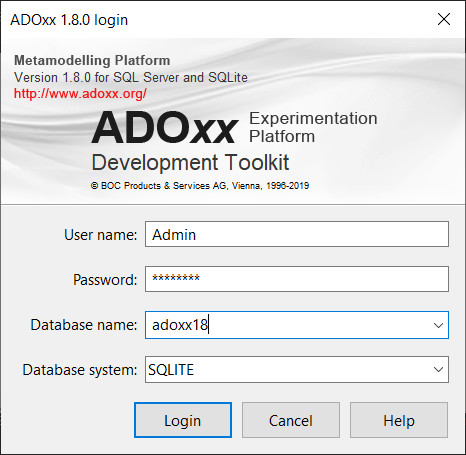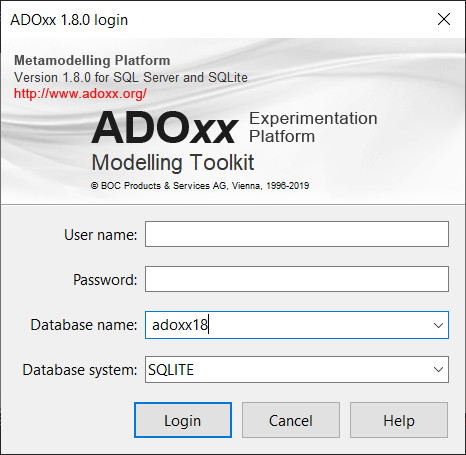Starting ADOxx
Once ADOxx is installed it provides two main applications:
- Development Toolkit: Tools used to develop own modelling languages and modelling methods to create a modelling tool.
- Modelling Toolkit: Tools for creating, managing and using models according to a modelling language / modelling method.
ADOxx based tools typically provide only the configured Modelling Toolkit.
Starting the Development Toolkit
The Development Toolkit provides tools for developing own modelling methods and modelling languages to create a modelling tool.
The preferable way to start the Development Toolkit is to use the provided shortcut. Alternatively you can run the aadma.exe executable located in the installation directory to start the Development Toolkit.
When starting the application it is necessary to log in.
When all relevant parameters are provided through arguments, then the login screen is skipped.
With a default installation the following values can be used:
- User:
Admin - Password:
password - Database name:
adoxx18 - Database system:
SQLITE
On macOS and Linux the application has to be started through Wine. This is taken care of by the shortcuts. To run the executable directly use a command like the following:
- macOS:
FREETYPE_PROPERTIES="truetype:interpreter-version=35" LANG=en_US WINEARCH=win64 WINEPREFIX="${HOME}/.wine_adoxx18" wine64 start /d "C:\\Program Files\\BOC\\ADOxx_1.8.0\\" "C:\\Program Files\\BOC\\ADOxx_1.8.0\\aadma.exe" - Linux:
LANG=en_US WINEARCH=win64 WINEPREFIX="${HOME}/.wine_adoxx18" wine64 start /d "C:\\Program Files\\BOC\\ADOxx_1.8.0\\" "C:\\Program Files\\BOC\\ADOxx_1.8.0\\aadma.exe"
Starting the Modelling Toolkit
The Modelling Toolkit provides tools for creating, managing and using models according to a modelling method / modelling language. ADOxx based tools typically provide only the Modelling Toolkit as a modelling tool.
The preferable way to start the Modelling Toolkit is to use the provided shortcut. Alternatively you can run the areena.exe executable located in the installation directory to start the Modelling Toolkit.
When starting the application it is necessary to log in.
When all relevant parameters are provided through arguments, then the login screen is skipped.
With a default installation the following values can be used:
- User name: any valid ADOxx user, like
Admin - Password: as specified for the ADOxx user, like
password - Database name:
adoxx18 - Database system:
SQLITE
On macOS and Linux the application has to be started through Wine. This is taken care of by the shortcuts. To run the executable directly use a command like the following:
- macOS:
FREETYPE_PROPERTIES="truetype:interpreter-version=35" LANG=en_US WINEARCH=win64 WINEPREFIX="${HOME}/.wine_adoxx18" wine64 start /d "C:\\Program Files\\BOC\\ADOxx_1.8.0\\" "C:\\Program Files\\BOC\\ADOxx_1.8.0\\areena.exe" - Linux:
LANG=en_US WINEARCH=win64 WINEPREFIX="${HOME}/.wine_adoxx18" wine64 start /d "C:\\Program Files\\BOC\\ADOxx_1.8.0\\" "C:\\Program Files\\BOC\\ADOxx_1.8.0\\areena.exe"
Hint
Each user can only be logged into one toolkit at a time. To make development of your modelling tool easier see Creating an ADOxx User for Testing / Debugging.
Arguments and Parameters
The executable files for the Development Toolkit (aadma.exe) and Modelling Toolkit (areena.exe) accept several arguments. These allow to specify various values and configuration options. Following a list of arguments grouped by similar cases:
-u[username]- Uses[username]as the user name for login. For example:-uAdmin.-p[password]- Uses[password]as the password for login. For example:-ppassword.-d[dbname]- Uses[dbname]as te database name for login. For example:-dadoxx18.-s[dbms]- Uses[dbms]as the database system for login. Can beSQLITEorSQLSERVER. For example:-sSQLITE.-x- Show the login dialog, even if all relevant information for logging in has been provided through the other arguments.-autokick- Will log out the specified user before logging them in again. Useful when the user is blocked due to a crash or something similar.-Portable- Starts in "portable mode". This only works when usingSQLITEas the database system. In "portable mode" the application looks in a relative foldersqlitedbs/for the database file. Note that the application requires write access to the database file, so "portable mode" typically fails when running from anywhere underC:\Program Files\. This argument can also be used withadbinst.exeto set up the portable database.-e[filepath]- Executes the AdoScript located in[filepath]after the application is initialized (login successful and library loaded). If[filepath]is omitted, then the content passed via standard input is processed instead, for example output ofechopassed via a pipe|in the command line. For example:-ehello_world.asc(relative path) or"-eC:\temp\hello world.asc"(absolute path with space in file name).-nodevcoupling- Prevents parsing the optionalado_dev_coupling.ascfile when starting the Development Toolkit.-no_printer_warning- Suppresses the warning shown after logging in when no default printer is installed / found.-h[fontsize]- Uses the provided[fontsize](in pt) for most texts of the user interface. Should be a value between 4 adn 48, for example-h14. The default is12.-f[fontname]- Uses the provided[fontname]for most texts of the user interface. Since font names typically contain spaces it is recommended to put the entire argument between double quotes. For example"-fCourier new".-trace- Log additional tracing information of the application's execution. Tracing information seems to be mainly about which database access functions are called when. Use-trfto specify a file to write the trace information to.-trf[filepath]- Writes the traceing information to the file specified through[filepath]. The file will be overwritten if already present or created if missing. There is no error when the application doesn't have write access to the path. Instead the tracing information is simply not written. For example:-trftrace.txt(relative path) or"-trfC:\temp\trace file.txt"(absolute path with space in file name).
When all relevant login information is specified through -u[username], -p[password], -d[dbname] and -s[dbms] and is valid, then the login screen is skipped and the user is taken directly into the application.
The -e argument allows to start a toolkit directly with web service support. See the the ADOxx Web Service page for further details.
